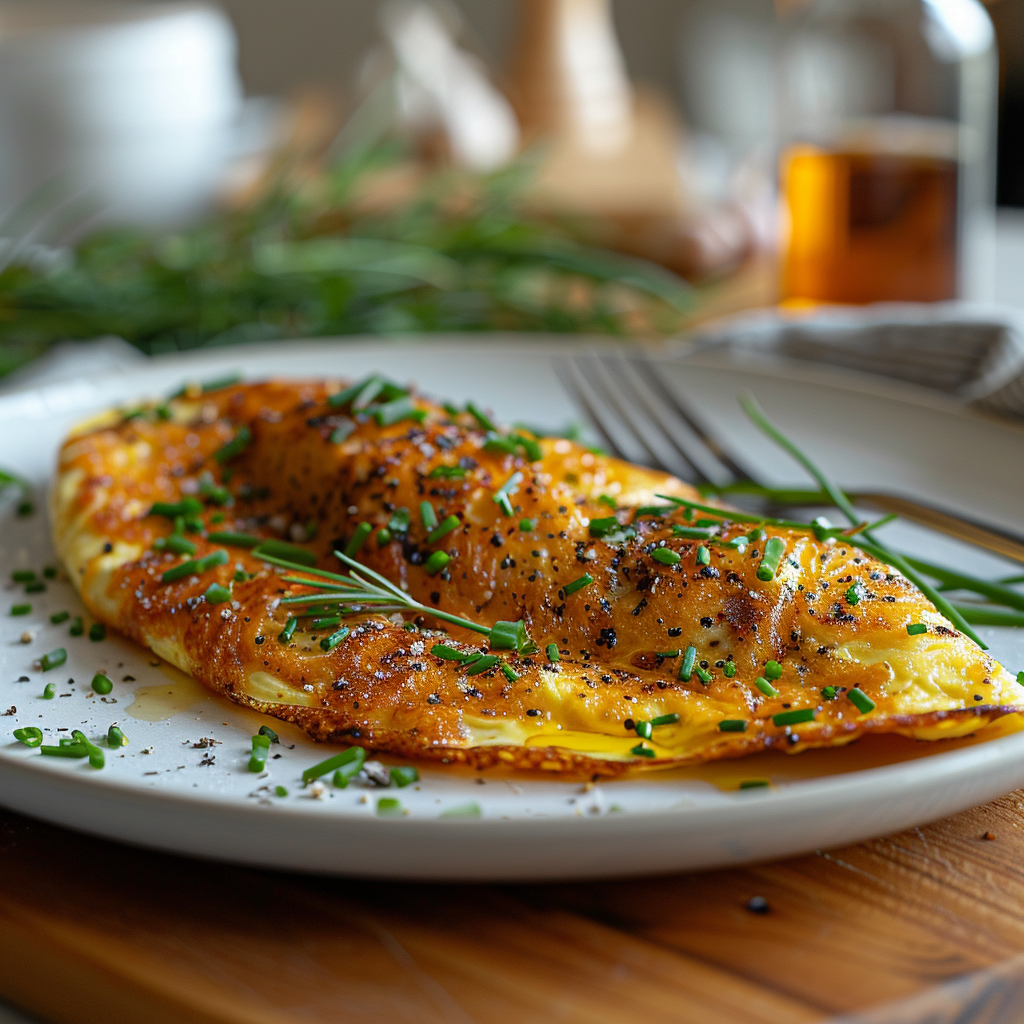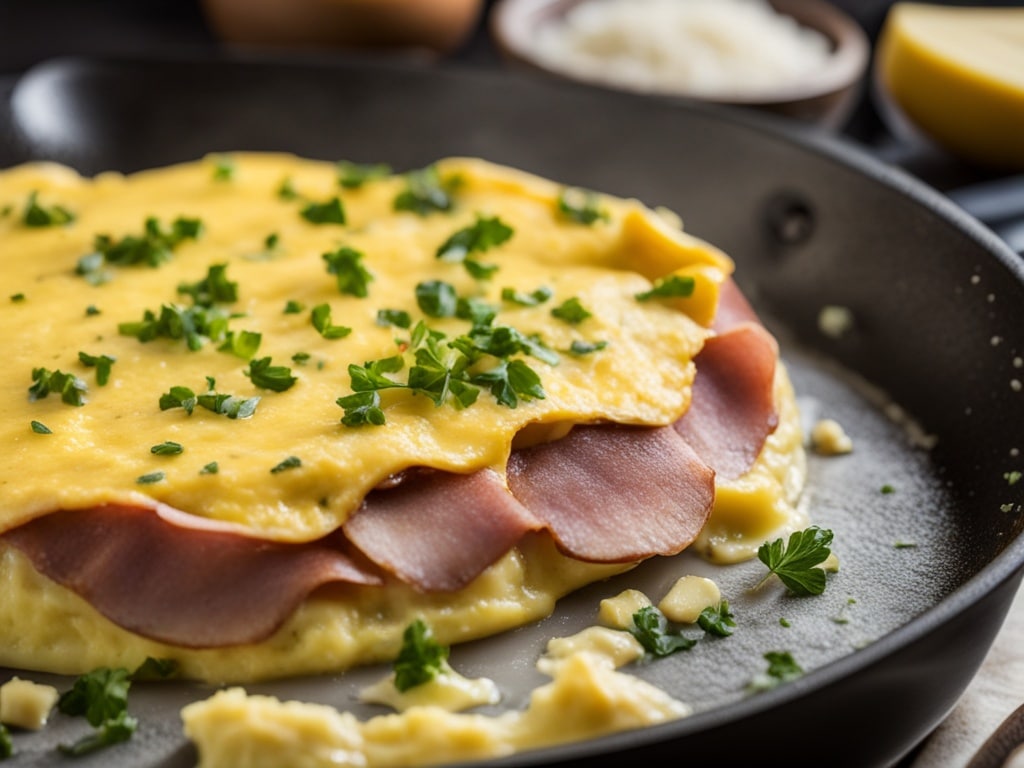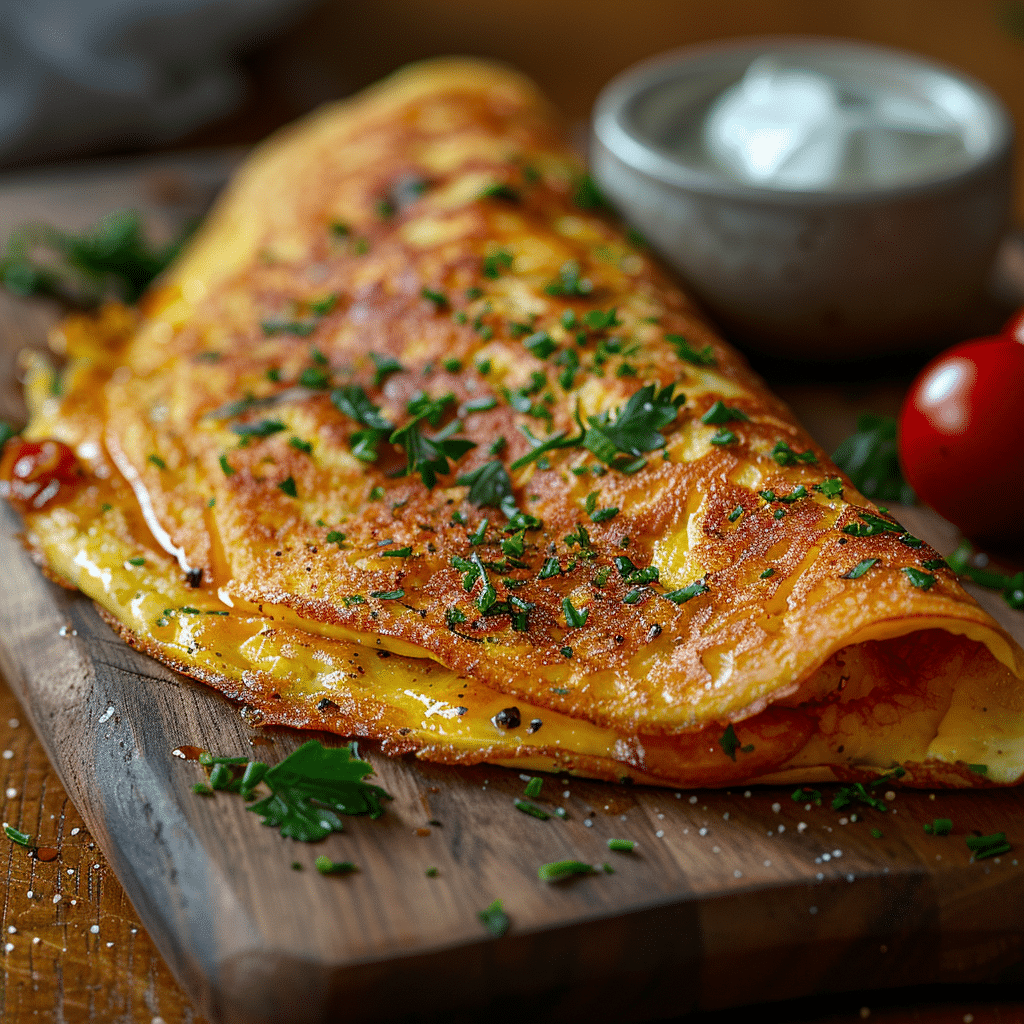Perfecting My French Omelet Recipe Adventure
Jump to Recipe
There comes a time when something normal turns into something amazing. For me, that’s when I learned how to make a perfect French omelet. In the beginning of my cooking career, I wanted to make that perfect, buttery, silky French omelet that you learn to make in less than 90 seconds. So far, I’ve been able to cut it down to about 100 seconds.
I’ve always been interested in the allure of traditional French cooking. There’s more to it than just the recipes. You must make each dish with care, precision, and love. Making the perfect French omelet wasn’t just about cooking; it was also about achieving a small yet significant victory in my kitchen.
I was excited to take on the challenge of making something delicious out of simple things like three eggs, a teaspoon of ghee or butter, shredded cheddar cheese, parsley, and green onions. A 10-inch skillet became my reliable friend and helped me on this cooking journey.
Imagine turning plain eggs into a smooth, tasty treat in just one to two minutes. There’s more to it than just a recipe. A way for me to bring a little bit of France into my house. Each time I make that trip, I get to enjoy a real taste of France right here on my plate.
The Art of French Cooking: A Beginner’s POV
Going on a journey to learn how to cook French food is both exciting and scary. For a beginner, the idea of making a perfectly folded French omelet was too tempting to pass up. However, the process presented unexpected problems and misunderstandings.
Many people think French recipes are too hard to understand. But I now know that they are about being precise and easy to understand. When I first tried to make a French omelet, it wasn’t even close to perfect. But after some time and practice, I learned to enjoy the subtleties of French food.
This guide is for people who are just starting to learn how to cook French-style. The first problem taught me that being patient is just as important as the technique itself. Getting past these problems made me appreciate this beautiful form of cooking even more. Every step taught me something new about finesse and pushed me to get better.

Ingredients and Tools Needed for a Classic French Omelet
You need more than just skill to make a classic French omelet. You also need the right ingredients and kitchen tools. Let’s now talk about where you need to start.
Basic Ingredients
Keep things simple and fresh to make a classic French omelet. What you’ll need:
- Three large eggs.
- Butter without salt
- Salt from the sea
- Ground black pepper just now
- Add chives or parsley as a garnish.
These simple ingredients for a classic French omelet are very important for their quality. Good butter, fresh eggs, and fragrant herbs are the building blocks of a great dish.
Essential Kitchen Tools
When making omelets, the tools you use are just as important as the food you use. This is what you’ll need:
- Pan that doesn’t stick (8 or 9 inches)
- Use a silicone-made spatula.
- Mixed-up bowl
- Whisk
Each of these tools is very important. The nonstick skillet evens out the cooking, and the silicone spatula makes it easy to fold and shape the omelet.
Where to Find Quality Ingredients
Getting good ingredients can make a big difference in how good your omelet tastes. For fresh eggs and herbs, I suggest going to a local farmers’ market. A lot of specialty stores sell good butter and sea salt.
Using these tips will help you make a better French omelet that tastes more like the real thing from Paris that you’ve always wanted.
Mastering the Technique
Learning how to make the perfect omelet takes time and skill. You can make French omelettes in a variety of ways because they typically contain two to three eggs. Mastering how to cook eggs is very important because it makes the difference between a simple dish and a delicious one.
French chefs prepare an omelet in just one or two minutes, while scrambled eggs require ten to fifteen minutes. With its mix of parsley, chervil, chives, and sometimes tarragon, the classic French omelette aux fines herbes is a great example of this quick and elegant way to make food. I always try to get this speed and finesse back.
It is essential to have the right tools. For the best French omelet recipe, you should use a white ceramic nonstick pan that is at least 10 inches wide. Having tools that serve multiple purposes, from a fork to a specialized tool like a Switchit, enhances precision. I’ve learned that butter, with its lower smoking temperature, gives me a better idea of when the pan is ready, which is very important for getting better at egg cooking.

Troubleshooting Common Mistakes
Mistakes can happen when making a French omelet, no matter how well you plan ahead. Home chefs who aspire to improve their skills must understand how to address these mistakes. Let’s look at some of the most common mistakes and how to fix them.
Preventing Overcooked Omelets
Controlling the heat is the key to keeping omelets from getting too done. When you cook on low to medium heat, you can control the heat better. I carefully watch the eggs and remove the pan from heat just as they begin to set. It keeps the soft, creamy texture that is important for a French omelet.
Getting the Range of the Pan
To make the perfect omelet fold, you need to know how to use your pan. It’s very important to use a non-stick pan. I make sure the pan is evenly hot before I add the eggs. If you know your pan’s “hot spots,” you can avoid uneven cooking and folds that don’t look good. You can get a feel for the range of your pan by practicing regularly.
Dealing with a Sticky Pan
Every cook hates it when their pan gets sticky. In order to avoid this, I always use a good nonstick pan and a lot of butter. The important thing is to heat the pan first, then add the butter and let it cover the whole bottom before adding the eggs. This method makes sure that the omelet lifts and folds perfectly, so it doesn’t stick.

Perfect French Omelet
Ingredients
Method
- Prepare Ingredients: Crack 3 large eggs into a mixing bowl. Add a pinch of salt and freshly ground black pepper. Whisk thoroughly until the mixture is smooth.
- Heat the Pan: Place an 8-inch nonstick skillet over medium-low heat. Add 1 teaspoon of unsalted butter and let it melt, coating the pan evenly.
- Cook the Eggs: Pour the whisked eggs into the skillet. Stir gently and continuously with a silicone spatula, ensuring the eggs cook evenly.
- Form the Omelet: As the eggs begin to set but are still slightly runny, stop stirring. Tilt the pan to let the eggs cover the bottom evenly.
- Fold the Omelet: Gently fold the omelet in thirds using the spatula. Slide it onto a plate.
- Garnish: Sprinkle fresh chives or parsley on top before serving.
Notes
- For a richer flavor, you can add a teaspoon of heavy cream to the eggs before whisking.
- Use fresh, high-quality eggs and butter for the best results.
- Practice makes perfect. Don't worry if your first few attempts aren't perfect; the technique will improve with time.
Q&A
What makes a French omelet different from other types of omelets?
A French omelet is different because the inside is a little runny and the outside is smooth and silky. Classic French cooking involves cooking it over medium-low heat and stirring slowly to make it creamy.
What are the basic ingredients for a classic French omelet?
You need fresh eggs, unsalted butter, salt, and freshly ground black pepper for a traditional French omelet. To get the flavor and texture you want, keep things simple and fresh.
What essential kitchen tools do I need to make a French omelet?
A nonstick skillet, a whisk, a spatula, and a mixing bowl are all important kitchen tools for making a French omelet. Having these tools will help you whisk the eggs properly and fold the omelet gently so that it doesn’t stick.
How can I find high-quality ingredients for my French omelet?
Farmers’ markets, specialty grocery stores, and organic food shops are all good places to find good ingredients. If you want your omelet to taste better, use fresh, free-range eggs and good, unsalted butter.
What are the common mistakes beginners make when cooking a French omelet?
People who are just starting out often cook their omelets too long, use bad ingredients, or heat them up too quickly or with too much heat. These mistakes can make the texture rubbery instead of the light and creamy one that you want.
How do I prevent my omelet from overcooking?
Use medium-low heat and stir the eggs all the time to make sure they cook evenly and don’t overcook. If you want the eggs to be perfectly silky, take the pan off the heat while they are still a little runny.
What tips can help me achieve the perfect fold in my French omelet?
A nonstick pan and a flexible spatula are must-haves for getting a perfect fold. To make sure the outside is smooth, tilt the pan gently and fold the omelet in thirds.
How do I deal with a sticky pan when making a French omelet?
Using a nonstick skillet and enough butter can help keep food from sticking. To make the surface non-stick, heat the pan evenly and make sure the butter melts completely before adding the eggs.
What’s the significance of mastering the omelet technique in French cooking?
Learning how to make an omelet means getting a better sense of French cooking principles like being precise, patient, and using good ingredients. It’s a basic skill that shows off the beauty and simplicity of French food.